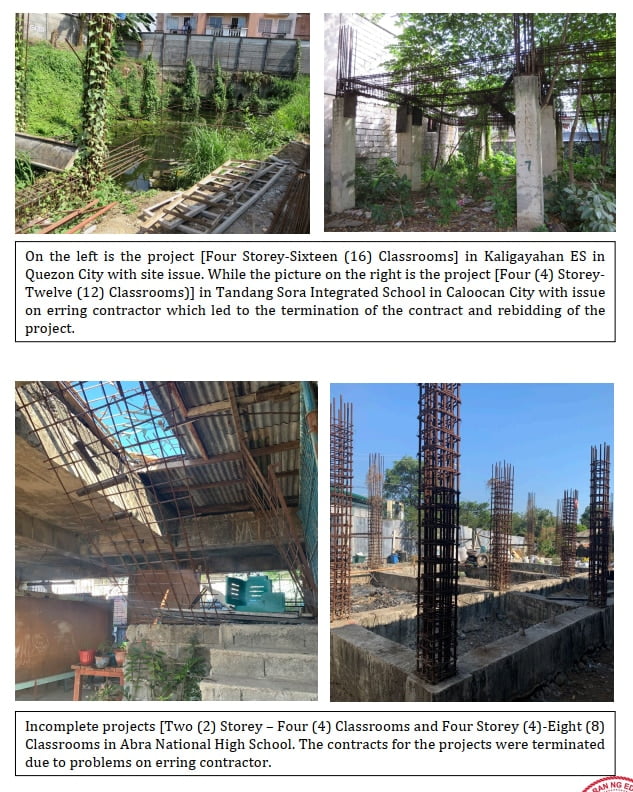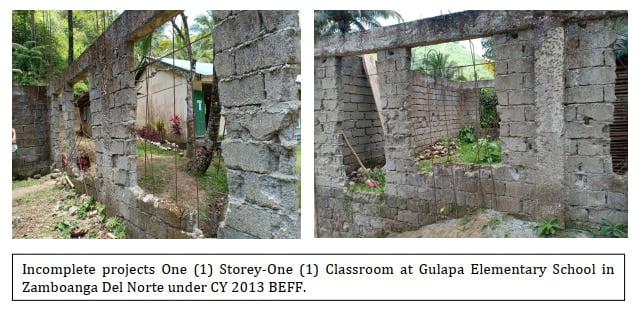Attached herewith is Aide Memoire dated June 02, 2020, from Alain Del B. Pascua, Undersecretary for Administration, DepEd Executive Committee, relative to Completing the Construction of Abandoned and Incomplete DepEd School Buildings.
Table of Contents
COMPLETING THE CONSTRUCTION OF ABANDONED AND INCOMPLETE SCHOOL BUILDINGS
The objective of the School Building Program of the Department of Education (DepEd) is to address the classroom gap in high priority schools. The timely delivery of the projects is vital to ensure that students have classrooms at the start of school opening or if not, during the school year. Likewise, the integrity of the structure or school building must be ensured during the construction to comply with the objective of the Department to provide a conducive, safe, and secure learning environment for our learners and school personnel.
However, some school building projects have not been completed and delivered on time, leading to congested classes due to classroom shortage. And while the reasons for the delays and non-completion vary, the objective remains to continue the implementation of the affected projects and complete them so that learners who were deprived of these structures can still benefit from them.
From 2014-2019, a total of 731 school building projects equivalent to 4,685 classrooms were reported by DPWH to be needing additional funds to complete due to several problems encountered during the implementation of the projects. These include poor planning, insufficient funding, erring contractors, difficult project locations, and those validated projects that have started implementation at risk.
Full funding for these affected projects were not realized from 2018-2020 due to the limited budget in the General Appropriation Act (GAA). While, these were reported and proposed to the Department of Budget and Management (DBM) for funding on top of the regular construction projects, only 1% of the appropriation was allowed to be used as Buffer Funds that can be used for the completion of the projects.
Below are some pictures of abandoned or incomplete projects:


Reasons for the incomplete and/or abandoned School Building Projects
Poor Planning
When the implementation of the program was transferred to the Department of Public Works and Highways (DPWH) in 2013, both departments were not ready, and there was a lack of planning.
Currently, Preliminary Detailed Engineering (PDE) Funds are provided under the GAA. The PDE funds are used by DepEd and DPWH for the conduct of preliminary site studies like soil exploration and structural analysis. But from 2013-2017, there were no PDE funds. Before the PDE fund was introduced, detailed estimates were prepared only based on the standard plans and do not include provisions for cost adjustments for a number of factors like actual site conditions such as changes in foundation designs, backfilling and demolition works, and other unforeseen works that are necessary to effectively complete the projects in accordance with standard engineering practices.
An example is the recommendation of DPWH to the outright conversion of the foundation design to mat or micropiling without thorough structural redesign or analysis. Micropiling or mat foundation were implemented whenever soil investigation results showed below 96 kPa, instead of increasing footing dimension, depth of footing elevation which can be considered as variables warranted by the soil test result. This has resulted to an abrupt increase in the project cost, thus needing additional amount for funding.
Insufficient Funding
The lack of planning has also resulted to the insufficient funds released for the affected projects. Revision of scope of works must be done to ensure the stability of the structure in the given site, for which funds must be used to prioritize the construction of the substructure of the affected buildings.
Based on actual site inspections in some critical sites, most of the funds were used for the substructure (below ground) portion of the buildings and only structural frames like beams and columns were constructed on the superstructure (above ground) portion of the building. In this case, additional funding is needed to complete the school building in accordance with the approved plans and specifications.
Erring Contractors
The DPWH has also had problems with contractors that do not follow the standard contract period, citing lack of manpower and equipment on site, and slow pace of work. Others do not follow the standard plans and specifications.
Due to this, the concerned DPWH District Engineering Offices have had to terminate the contracts of these erring contractors. As a result, they have to review the remaining scope of works for the projects and if the remaining funds are sufficient to complete them. In most cases, DPWH requests for additional funds, particularly if projects were funded in 2016 and current increased prices of materials have already affected the total project cost.
Difficult Project Locations
Access is also one of the reasons why projects from past years remain incomplete. There was a lack of actual site validation, which should be done jointly by DepEd and DPWH Engineers. Some priority schools are located in far-flung areas and are hard to access.
Due to poor coordination and the limited time to do actual site validation, the necessary hauling costs have not been included in the detailed estimates of DPWH. As a result, reprogramming was done during implementation where painting, ceiling works, and electrical works were excluded in the program. Some classrooms also have no windows or doors.
Compliance to the Requirements of Permitting Authorities
In the previous year’s implementation of the School Building Program, the cost for securing Demolition Permits, Building Permit, Fire Safety Permit and other necessary permits were not included in the program of works and funds allocated for the project. In this case, DPWH has requested for buffer funds to accommodate these requirements.
To date, these items are already included in the preparation of the Detailed Estimates and budget allocation.
Validated Projects that Were Started at Risk
Some district officers have taken the risk of implementing the school building projects without waiting for the inclusion in the official list of projects for implementation and funding.
While early procurement is allowed based on the projects identified in the National Expenditure Program (NEP) submitted by DBM in Congress, the final list of projects will be determined by the actual budget allocation by Congress and by the approval of the President of the General Appropriations Act. In some instances, Congress reduces the NEP allocation, while in other circumstances, the President vetoes the allocations approved or inserted by Congress. As such, the projects earlier procured do not have fund cover.
Actions Being Taken by DPWH
DepEd reports to the DPWH Central Office the list of abandoned and unfinished projects at the field level. In response, DPWH usually dispatches their Quality Assurance Unit (QAU) to validate the complaints and determine the necessary actions to be taken.
While majority of these reported cases have been resolved, and projects have been completed, several projects require additional funding in order to be completed.
Budget Needed to Complete the Affected Projects
| REGION | NO. OF SITES | TOTAL NO. OF CL | Additional Fund Needed to Complete the Projects |
|---|---|---|---|
| CAR | 2 | 8 | 6,753,645.83 |
| CARAGA | 2 | 14 | 267,961.08 |
| NCR | 23 | 292 | 81,929,679.70 |
| Region 1 | 73 | 459 | 143,282,227.44 |
| Region II | 65 | 460 | 202,653,269.70 |
| Region III | 120 | 783 | 404,084,579.33 |
| Region IV-A | 18 | 239 | 97,956,974.34 |
| Region IV-B | 17 | 129 | 71,852,248.87 |
| Region IX | 33 | 306 | 102,873,789.57 |
| Region V | 40 | 447 | 250,714,155.23 |
| Region VI | 67 | 538 | 195,556,287.99 |
| Region VII | 233 | 800 | 301,093,304.22 |
| Region VIII | 17 | 57 | 13,020,367.98 |
| Region X | 9 | 69 | 28,887,876.35 |
| Region XI | 6 | 36 | 13,439,623.20 |
| Region XII | 6 | 48 | 6,526,584.93 |
| Grand Total | 731 | 4,685 | 1,920,892,575.76 |
Based on DPWH reports and requests for additional funds or buffer funds, the total amount needed to complete the existing abandoned or incomplete projects is Pl.92 billion, as of May 2020. The summary is shown on the table above while the specific list of projects is attached in Annex A of this report.
The funding requirement of Pl.92 billion is proposed to be included in FY2021.
ALAIN DEL B. PASCUA
Undersecretary
I saw this the time i visit Manila. I think that was 2017 or 18. the case of an unfinished faculty constructing in Balulang National High School in Cagayan de Oro city. The constructing, which became first commenced in 2014 below the Public Private Partnership framework, had languished incomplete due to the fact that contractors deserted it mid-production over a investment dispute. anyway’s thanks Mark for sharing this blog.